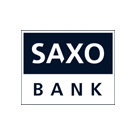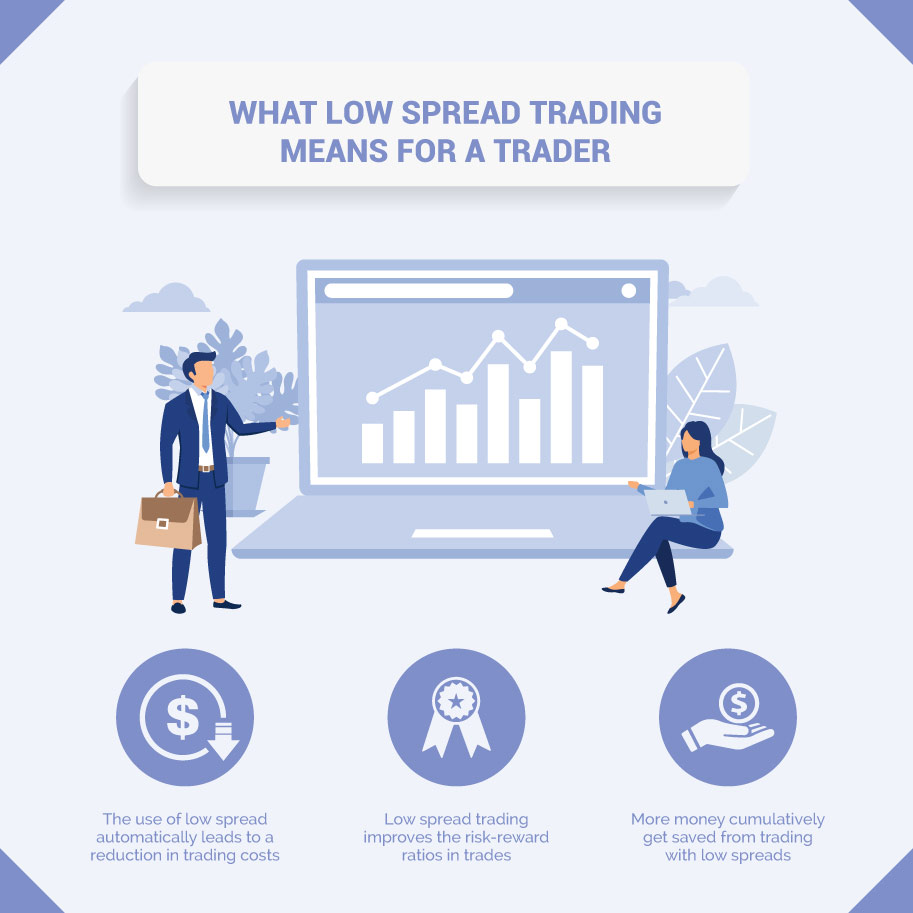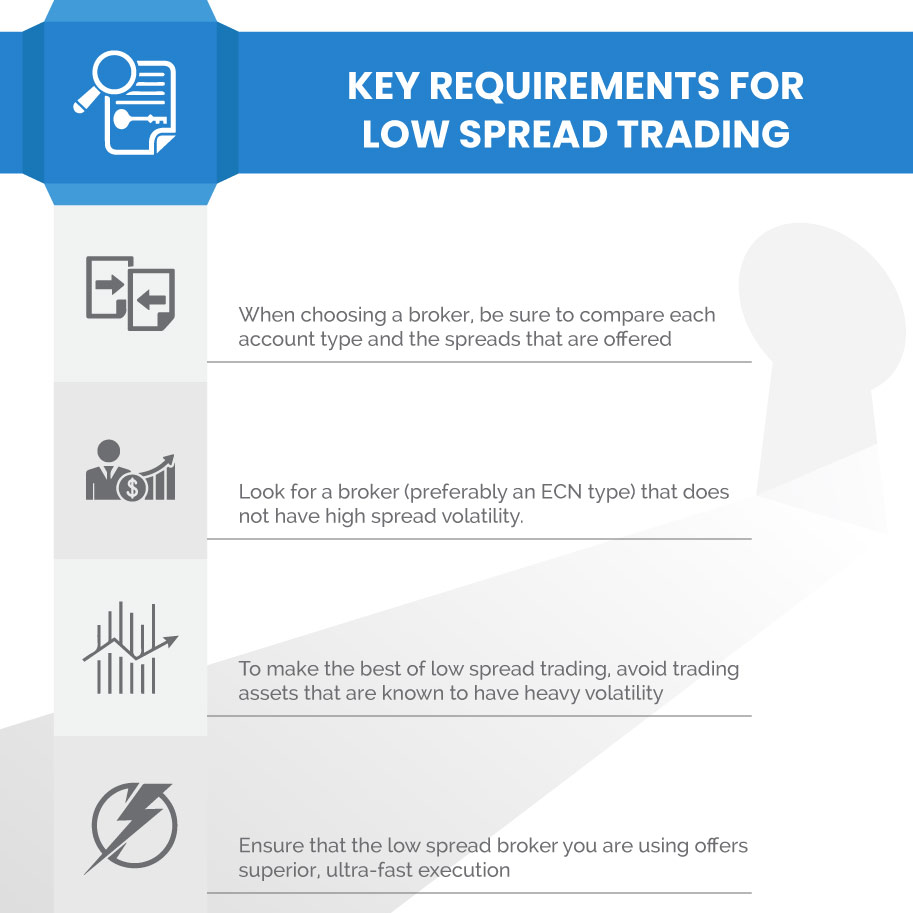Below you will find a list of Forex Brokers that have relatively low spreads on major currency pairs. Spread size plays an important role in trading, especially for scalpers and intraday traders. Most favorable conditions are usually offered on STP and ECN accounts. Occasionally, you can even catch a glimpse of a zero spread on EURUSD. Nevertheless, keep in mind that spreads get wider at low liquidity periods of time and on market news releases. Furthermore, the broker may charge an additional commission everytime you open or close a trade. On currency pairs, it usually stays around 2-5 USD per side, for every 1.0 lot traded. On other different CFDs, it can be notably higher.

 RoboForex (2009)
Leverage: up to 1:2000
Deposit: from 10 USD
Spreads:
RoboForex (2009)
Leverage: up to 1:2000
Deposit: from 10 USD
Spreads: 


















 4XC (2018)
Leverage: up to 1:500
Deposit: from 10 USD
Spreads:
4XC (2018)
Leverage: up to 1:500
Deposit: from 10 USD
Spreads: 






 FirewoodFX (2014)
Leverage: up to 1:3000
Deposit: from 10 USD
Spreads:
FirewoodFX (2014)
Leverage: up to 1:3000
Deposit: from 10 USD
Spreads: 




 TradeView (2004)
Leverage: up to 1:400
Deposit: from 100 USD
Spreads:
TradeView (2004)
Leverage: up to 1:400
Deposit: from 100 USD
Spreads: 












 PrimeXBT (2018)
Leverage: up to 1:1000
Deposit: from 0.0001 BTC
Spreads:
PrimeXBT (2018)
Leverage: up to 1:1000
Deposit: from 0.0001 BTC
Spreads: 






 MultiBank Group (2005)
Leverage: up to 1:500
Deposit: from 50 USD
Spreads:
MultiBank Group (2005)
Leverage: up to 1:500
Deposit: from 50 USD
Spreads: 








 xChief (2014)
Leverage: up to 1:1000
Deposit: from 10 USD
Spreads:
xChief (2014)
Leverage: up to 1:1000
Deposit: from 10 USD
Spreads: 











 Solid ECN (2021)
Leverage: up to 1:1000
Deposit: from 1 USD
Spreads:
Solid ECN (2021)
Leverage: up to 1:1000
Deposit: from 1 USD
Spreads: 






 FXCC (2010)
Leverage: up to 1:500 *
Deposit: from 20 USD
Spreads:
FXCC (2010)
Leverage: up to 1:500 *
Deposit: from 20 USD
Spreads: 











 ForexMart (2015)
Leverage: up to 1:3000
Deposit: from 15 USD
Spreads:
ForexMart (2015)
Leverage: up to 1:3000
Deposit: from 15 USD
Spreads: 







 PF Derivatives (1999)
Leverage: up to 1:300
Deposit: from 5 USD
Spreads:
PF Derivatives (1999)
Leverage: up to 1:300
Deposit: from 5 USD
Spreads: 









 FP Markets (2005)
Leverage: up to 1:500 *
Deposit: from 100 AUD
Spreads:
FP Markets (2005)
Leverage: up to 1:500 *
Deposit: from 100 AUD
Spreads: 















 TIO Markets (2019)
Leverage: up to 1:1000 *
Deposit: from 10 USD
Spreads:
TIO Markets (2019)
Leverage: up to 1:1000 *
Deposit: from 10 USD
Spreads: 







 M4Markets (2019)
Leverage: up to 1:1000 *
Deposit: from 5 USD
Spreads:
M4Markets (2019)
Leverage: up to 1:1000 *
Deposit: from 5 USD
Spreads: 









 IC Markets (2007)
Leverage: up to 1:500 *
Deposit: from 200 USD
Spreads:
IC Markets (2007)
Leverage: up to 1:500 *
Deposit: from 200 USD
Spreads: 










 GO Markets (2006)
Leverage: up to 1:500 *
Deposit: from 200 AUD
Spreads:
GO Markets (2006)
Leverage: up to 1:500 *
Deposit: from 200 AUD
Spreads: 






 FxOpen (2005)
Leverage: up to 1:500 *
Deposit: from 1 USD
Spreads:
FxOpen (2005)
Leverage: up to 1:500 *
Deposit: from 1 USD
Spreads: 















 CityIndex (1983)
Leverage: up to 1:30
Deposit: from 10 USD
Spreads:
CityIndex (1983)
Leverage: up to 1:30
Deposit: from 10 USD
Spreads: 



 Darwinex (2012)
Leverage: up to 1:30
Deposit: from 500 USD
Spreads:
Darwinex (2012)
Leverage: up to 1:30
Deposit: from 500 USD
Spreads: 





 Alpari (1998)
Leverage: up to 1:3000
Deposit: from 1 USD
Spreads:
Alpari (1998)
Leverage: up to 1:3000
Deposit: from 1 USD
Spreads: 













 Anzo Capital (2015)
Leverage: up to 1:1000
Deposit: from 100 USD
Spreads:
Anzo Capital (2015)
Leverage: up to 1:1000
Deposit: from 100 USD
Spreads: 


 IG Markets (1974)
Leverage: up to 1:200 *
Deposit: from 300 USD
Spreads:
IG Markets (1974)
Leverage: up to 1:200 *
Deposit: from 300 USD
Spreads: 



 OctaFX (2011)
Leverage: up to 1:1000
Deposit: from 25 USD
Spreads:
OctaFX (2011)
Leverage: up to 1:1000
Deposit: from 25 USD
Spreads: 







 TickMill (2015)
Leverage: up to 1:500 *
Deposit: from 100 USD
Spreads:
TickMill (2015)
Leverage: up to 1:500 *
Deposit: from 100 USD
Spreads: 










 AvaTrade (2007)
Leverage: up to 1:400 *
Deposit: from 100 USD
Spreads:
AvaTrade (2007)
Leverage: up to 1:400 *
Deposit: from 100 USD
Spreads: 














 Admiral Markets (2001)
Leverage: up to 1:1000 *
Deposit: from 200 USD
Spreads:
Admiral Markets (2001)
Leverage: up to 1:1000 *
Deposit: from 200 USD
Spreads: 












 Dukascopy (1998)
Leverage: up to 1:200
Deposit: from 100 USD
Spreads:
Dukascopy (1998)
Leverage: up to 1:200
Deposit: from 100 USD
Spreads: 

 XM Group (2009)
Leverage: up to 1:1000 *
Deposit: from 5 USD
Spreads:
XM Group (2009)
Leverage: up to 1:1000 *
Deposit: from 5 USD
Spreads: 



 Z.com Trade (2011)
Leverage: up to 1:30
Deposit: from 50 USD
Spreads:
Z.com Trade (2011)
Leverage: up to 1:30
Deposit: from 50 USD
Spreads: 













 Global Prime (2010)
Leverage: up to 1:100
Deposit: from 200 AUD
Spreads:
Global Prime (2010)
Leverage: up to 1:100
Deposit: from 200 AUD
Spreads: 










 Exness (2008)
Leverage: up to 1:2000 *
Deposit: from 1 USD
Spreads:
Exness (2008)
Leverage: up to 1:2000 *
Deposit: from 1 USD
Spreads: 









 Axi (2007)
Leverage: up to 1:500 *
Deposit: from 1 USD
Spreads:
Axi (2007)
Leverage: up to 1:500 *
Deposit: from 1 USD
Spreads: 






 LMFX (2015)
Leverage: up to 1:1000
Deposit: from 50 USD
Spreads:
LMFX (2015)
Leverage: up to 1:1000
Deposit: from 50 USD
Spreads: 






 CoreSpreads (2014)
Leverage: up to 1:30
Deposit: from 10 USD
Spreads:
CoreSpreads (2014)
Leverage: up to 1:30
Deposit: from 10 USD
Spreads: 


 CMC Markets (1989)
Leverage: up to 1:500 *
Deposit: from 200 USD
Spreads:
CMC Markets (1989)
Leverage: up to 1:500 *
Deposit: from 200 USD
Spreads: 


 Vipro Markets (2015)
Leverage: up to 1:500 *
Deposit: from 100 USD
Spreads:
Vipro Markets (2015)
Leverage: up to 1:500 *
Deposit: from 100 USD
Spreads: 










 PaxForex (2010)
Leverage: up to 1:500
Deposit: from 10 USD
Spreads:
PaxForex (2010)
Leverage: up to 1:500
Deposit: from 10 USD
Spreads: 










 TradersWay (2011)
Leverage: up to 1:1000
Deposit: from 5 USD
Spreads:
TradersWay (2011)
Leverage: up to 1:1000
Deposit: from 5 USD
Spreads: 










 AAFX (2015)
Leverage: up to 1:2000
Deposit: from 100 USD
Spreads:
AAFX (2015)
Leverage: up to 1:2000
Deposit: from 100 USD
Spreads: 







 AAAFx (2007)
Leverage: up to 1:500 *
Deposit: from 10 USD
Spreads:
AAAFx (2007)
Leverage: up to 1:500 *
Deposit: from 10 USD
Spreads: 













 Plus500 (2008)
Leverage: up to 1:300
Deposit: from 100 USD
Spreads:
Plus500 (2008)
Leverage: up to 1:300
Deposit: from 100 USD
Spreads: 



 EightCap (2009)
Leverage: up to 1:500
Deposit: from 100 USD
Spreads:
EightCap (2009)
Leverage: up to 1:500
Deposit: from 100 USD
Spreads: 










 MTrading (2014)
Leverage: up to 1:1000
Deposit: from 100 USD
Spreads:
MTrading (2014)
Leverage: up to 1:1000
Deposit: from 100 USD
Spreads: 







 BCR (2008)
Leverage: up to 1:400
Deposit: from 300 USD
Spreads:
BCR (2008)
Leverage: up to 1:400
Deposit: from 300 USD
Spreads: 






 SimpleFX (2014)
Leverage: up to 1:500
Deposit: from 1 USD
Spreads:
SimpleFX (2014)
Leverage: up to 1:500
Deposit: from 1 USD
Spreads: 






 Forex.ee (1998)
Leverage: up to 1:500
Deposit: from 50 USD
Spreads:
Forex.ee (1998)
Leverage: up to 1:500
Deposit: from 50 USD
Spreads: 











 Forex4you (2007)
Leverage: up to 1:1000
Deposit: from 1 USD
Spreads:
Forex4you (2007)
Leverage: up to 1:1000
Deposit: from 1 USD
Spreads: 





 Advanced Markets (2006)
Leverage: up to 1:100
Deposit: from 2500 USD
Spreads:
Advanced Markets (2006)
Leverage: up to 1:100
Deposit: from 2500 USD
Spreads: 
 NordFX (2008)
Leverage: up to 1:1000
Deposit: from 10 USD
Spreads:
NordFX (2008)
Leverage: up to 1:1000
Deposit: from 10 USD
Spreads: 










 Renesource Capital (1998)
Leverage: up to 1:30
Deposit: from 10 USD
Spreads:
Renesource Capital (1998)
Leverage: up to 1:30
Deposit: from 10 USD
Spreads: 
 Finotec (2007)
Leverage: up to 1:30
Deposit: from 200 USD
Spreads:
Finotec (2007)
Leverage: up to 1:30
Deposit: from 200 USD
Spreads: 

 AMarkets (2007)
Leverage: up to 1:3000
Deposit: from 100 USD
Spreads:
AMarkets (2007)
Leverage: up to 1:3000
Deposit: from 100 USD
Spreads: 









 Price Markets (2013)
Leverage: up to 1:30
Deposit: from 500 USD
Spreads:
Price Markets (2013)
Leverage: up to 1:30
Deposit: from 500 USD
Spreads: 











 Saxo Bank (1992)
Leverage: up to 1:30
Deposit: from 2000 USD
Spreads:
Saxo Bank (1992)
Leverage: up to 1:30
Deposit: from 2000 USD
Spreads: 

 Arum Capital (2017)
Leverage: up to 1:30
Deposit: from 500 USD
Spreads:
Arum Capital (2017)
Leverage: up to 1:30
Deposit: from 500 USD
Spreads: 




 Pepperstone (2010)
Leverage: up to 1:200
Deposit: from 200 AUD
Spreads:
Pepperstone (2010)
Leverage: up to 1:200
Deposit: from 200 AUD
Spreads: 









 Think Markets (2010)
Leverage: up to 1:500 *
Deposit: from 5 USD
Spreads:
Think Markets (2010)
Leverage: up to 1:500 *
Deposit: from 5 USD
Spreads: 







 Xtream Markets (2015)
Leverage: up to 1:1000
Deposit: from 5 USD
Spreads:
Xtream Markets (2015)
Leverage: up to 1:1000
Deposit: from 5 USD
Spreads: 










 JustForex (2012)
Leverage: up to 1:3000
Deposit: from 1 USD
Spreads:
JustForex (2012)
Leverage: up to 1:3000
Deposit: from 1 USD
Spreads: 







 Infinox (2009)
Leverage: up to 1:1000
Deposit: from 50 USD
Spreads:
Infinox (2009)
Leverage: up to 1:1000
Deposit: from 50 USD
Spreads: 








 FXPrimus (2009)
Leverage: up to 1:1000
Deposit: from 15 USD
Spreads:
FXPrimus (2009)
Leverage: up to 1:1000
Deposit: from 15 USD
Spreads: 








 VantageFX (2009)
Leverage: up to 1:500
Deposit: from 200 USD
Spreads:
VantageFX (2009)
Leverage: up to 1:500
Deposit: from 200 USD
Spreads: 









 TeleTrade (2000)
Leverage: up to 1:500
Deposit: from 10 USD
Spreads:
TeleTrade (2000)
Leverage: up to 1:500
Deposit: from 10 USD
Spreads: 






 BlackBull Markets (2014)
Leverage: up to 1:500
Deposit: from 1 USD
Spreads:
BlackBull Markets (2014)
Leverage: up to 1:500
Deposit: from 1 USD
Spreads: 











 Skilling (2016)
Leverage: up to 1:500
Deposit: from 100 USD
Spreads:
Skilling (2016)
Leverage: up to 1:500
Deposit: from 100 USD
Spreads: 










 Axiory (2012)
Leverage: up to 1:500
Deposit: from 100 USD
Spreads:
Axiory (2012)
Leverage: up to 1:500
Deposit: from 100 USD
Spreads: 






 XBTFX (2019)
Leverage: up to 1:500
Deposit: from 0.0001 BTC
Spreads:
XBTFX (2019)
Leverage: up to 1:500
Deposit: from 0.0001 BTC
Spreads: 










 Just2Trade (2015)
Leverage: up to 1:30
Deposit: from 100 USD
Spreads:
Just2Trade (2015)
Leverage: up to 1:30
Deposit: from 100 USD
Spreads: 


















 Arum Trade (2018)
Leverage: up to 1:200
Deposit: from 1 USD
Spreads:
Arum Trade (2018)
Leverage: up to 1:200
Deposit: from 1 USD
Spreads: 



 Hankotrade (2018)
Leverage: up to 1:500
Deposit: from 10 USD
Spreads:
Hankotrade (2018)
Leverage: up to 1:500
Deposit: from 10 USD
Spreads: 




 FxPig (2011)
Leverage: up to 1:500
Deposit: from 200 USD
Spreads:
FxPig (2011)
Leverage: up to 1:500
Deposit: from 200 USD
Spreads: 





 iForex (2012)
Leverage: up to 1:400 *
Deposit: from 100 USD
Spreads:
iForex (2012)
Leverage: up to 1:400 *
Deposit: from 100 USD
Spreads: 



 TMGM (2013)
Leverage: up to 1:500
Deposit: from 100 USD
Spreads:
TMGM (2013)
Leverage: up to 1:500
Deposit: from 100 USD
Spreads: 








 ETX Capital (1965)
Leverage: up to 1:30
Deposit: from 100 USD
Spreads:
ETX Capital (1965)
Leverage: up to 1:30
Deposit: from 100 USD
Spreads: 




 Fondex (2017)
Leverage: up to 1:500
Deposit: from 1 USD
Spreads:
Fondex (2017)
Leverage: up to 1:500
Deposit: from 1 USD
Spreads: 
















 Doo Prime (2014)
Leverage: up to 1:400
Deposit: from 100 USD
Spreads:
Doo Prime (2014)
Leverage: up to 1:400
Deposit: from 100 USD
Spreads: 







 ForexVox (2020)
Leverage: up to 1:500
Deposit: from 100 USD
Spreads:
ForexVox (2020)
Leverage: up to 1:500
Deposit: from 100 USD
Spreads: 







 AZAforex (2016)
Leverage: up to 1:1000
Deposit: from 1 USD
Spreads:
AZAforex (2016)
Leverage: up to 1:1000
Deposit: from 1 USD
Spreads: 














 Trade Nation (2019)
Leverage: up to 1:200
Deposit: from 10 USD
Spreads:
Trade Nation (2019)
Leverage: up to 1:200
Deposit: from 10 USD
Spreads: 


 VT Markets (2016)
Leverage: up to 1:500
Deposit: from 50 USD
Spreads:
VT Markets (2016)
Leverage: up to 1:500
Deposit: from 50 USD
Spreads: 






The major trading cost to the forex trader is the spread, which is the difference between the bid and ask prices of a forex pair. The desire to get the lowest trading spreads has become one of the major forex brokerage selection criteria.
There is a lot of competition for traders in the market right now, and one of the incentives used by brokers is to offer lower spreads than the competition. This article will seek to explain the benefits of using low spreads, and will introduce the low spread forex brokers that we have identified as being the best for you to work with.
Spreads are the difference between the bid and ask prices in the market. To explain this further, the spread is the difference between the price at which the dealer buys the asset from another trader or from the interbank market, and what the trader eventually buys the asset from the dealer. The difference is known as the spread and represents the compensation to the broker for providing the trader with access to the forex market.
Spreads are a function of how much a broker is willing to sell an asset to traders, as well as how liquid the asset is. Liquid currency pairs such as the EUR/USD and GBP/USD typically attract lower spreads than the illiquid pairings that feature currencies such as the Norwegian, Danish and Swedish Crowns, or the South African Rand. Spreads can also be affected by volatility, and it is possible for spreads to widen considerably when the markets are very volatile: a phenomenon known as slippage.
Trading costs are cumulative and can add up quickly. That is why it is essential to operate with a broker that not only gives you low spreads under normal market conditions, but also under conditions of excessive volatility. Such forex companies are the best low spread brokers.
It is all about being able to keep more money in your pocket at the end of the day. In the following sections, a demonstration will be made of how tight spreads can impact the trader’s capital in monetary terms and how much can be saved over time from even the minutest reductions in spread.
The use of low spread brokers impacts traders in several ways.

Perhaps the most important factor here has to do with how much a trader can save from trading with low spread brokers, and this is typified in the example that is set out below.
A trader wants to trade 5 Standard Lots position (worth $50 per pip) on GBP/USD using an ECN platform and is offered the following prices by one liquidity provider:
Another liquidity provider offers the trader pricing as follows:
Trade execution using Broker 1’s pricing with a spread of 1.5 pips will lead to a spread cost of $75. Execution using Broker 2’s pricing will lead to a spread cost of $50. Savings on the spread for this trade will be $75 -$50 = $25.
Assuming the trader takes 20 of such trades in a month, this translates into savings of $25 X 20 = $500. 250 of such trades in a year will lead to savings of $25 X 250 = $6,250.
When trading CFDs on commodities or trading assets such as gold which usually have large spreads, there can be significant cost savings on spreads between two brokers. This goes to show the benefit of using low spread brokers for trading.
It is one thing for a broker to advertise “low” spreads, but it is another thing for the trader to really get these tight spreads in real market conditions. Here are the key things to look out for to ensure that you are really trading with low spreads.

Our list of low spread brokers features brokers from various jurisdictions. These brokers offer some of the lowest spreads over a wide range of markets. Some of the brokers have ECN platforms and can provide you with aggregated pricing from various liquidity providers. For instance, TradeView has close to 5,000 assets that can be traded on its platforms, using low spreads, and typically uses its proprietary price aggregation engine to deliver pricing from as many as 8 liquidity providers.
Feel free to check out each of these brokers and what they have to offer, and start trading under tight spread conditions today for more profitable and cost-effective trading.